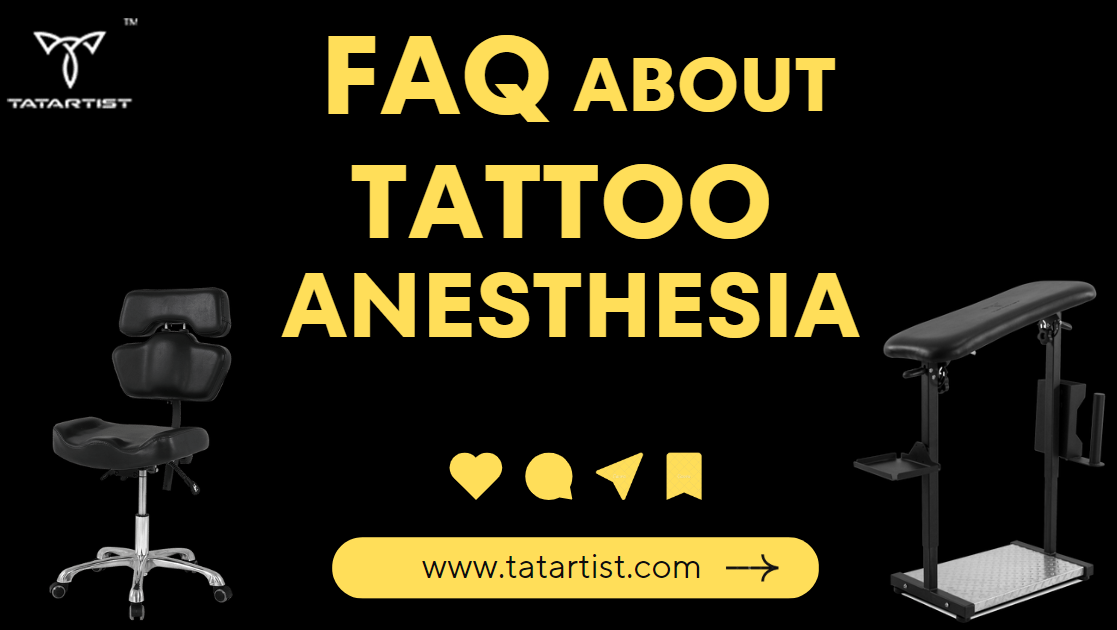TATARTIST Tatttoo Furniture
Q: Can anesthesia be used during tattooing?
A: Anesthesia can be used during the tattooing process, and one common type is local anesthesia. Local anesthesia works by blocking nerve conduction to reduce or eliminate the pain sensation during tattooing.
The decision to use anesthesia is usually made through a discussion between the tattoo artist and the client. Factors such as the location and size of the tattoo, the client's pain sensitivity, and the experience and technique of the tattoo artist can influence whether anesthesia is used or not.
It's important to note that using anesthesia during tattooing may come with potential risks and side effects, including allergic reactions, toxicity, local irritation and pain, and nerve damage. Therefore, proper dosage and administration should be followed, and it should be done under the guidance of a professional.
In some cases, tattoo artists may require specific qualifications or licenses to use anesthesia. This may vary depending on regional regulations and industry standards. Tattoo artists typically undergo relevant training and certification to ensure they can safely and responsibly use anesthesia.
Overall, the decision to use anesthesia during the tattooing process is an individualized one that should be discussed and considered between the tattoo artist and the client, and done under professional guidance.
Q: What is the most essential step in the tattooing process?
A: Comfort and pain management are crucial aspects in the tattooing process, and here are four reasons explaining their importance:

Enhancing comfort and satisfaction: Tattooing often involves prolonged manipulation of the skin, which can cause varying degrees of pain and discomfort. Effective pain management can alleviate the client's discomfort during the tattooing process, improving their comfort and satisfaction. This helps the client enjoy the tattooing experience more and increases their satisfaction with the final result.
Alleviating anxiety and stress: For some individuals, the tattooing process may trigger anxiety and nervousness. Pain management can help reduce the client's anxiety and stress, allowing them to approach the tattooing process in a more relaxed manner. Reducing anxiety and tension enables the artist to work better and provides a better tattooing experience.
Improving collaboration and communication between artist and client: Pain management also plays an important role for the artist during the tattooing process. When clients experience less pain, they are more likely to cooperate and communicate effectively with the artist. This helps the artist better understand the client's needs and expectations, making adjustments in tattoo design and technique for optimal results.
Reducing complications and disturbances: Pain during tattooing can lead to physical reactions in clients, such as fainting, vomiting, or excessive tension. Effective pain management can minimize these potential complications and disturbances, ensuring a smooth tattooing process and reducing any possible risks.
Overall, the importance of pain management in the tattooing process cannot be overlooked. It not only improves client comfort and satisfaction, but also reduces anxiety and stress, enhances collaboration and communication between the artist and client, and minimizes potential complications. Proper pain management ensures a smooth tattooing process and maximizes the realization of client expectations and artist's skills.
Q: What are some commonly used local anesthetics for tattooing?
-
Lidocaine: Lidocaine is a commonly used local anesthetic to alleviate pain during tattooing. It can be administered in the form of sprays, ointments, or injections.
-
Bupivacaine: Bupivacaine is another common local anesthetic with a longer duration of action, providing more prolonged pain relief.
-
Prilocaine HCl: Prilocaine is also a commonly used local anesthetic with a faster onset and shorter duration of action.
-
Tetracaine: Tetracaine is a potent local anesthetic used in cases where stronger pain relief is required.
Q:What are the precautions when using anesthesia for tattooing?
A:When using local anesthesia for tattoos, it is important to consider the following 6 points:

- Proper dosage and concentration: Ensure the correct dosage and concentration of the anesthesia. An excessive dosage may lead to side effects or adverse reactions, while an insufficient dosage may not provide adequate pain relief. Follow the advice and guidance of medical professionals.
- Individual differences and allergic reactions: Different individuals may have varying responses to local anesthesia. Before use, tattoo artists and clients should discuss any history of allergies and individual sensitivities to ensure safe usage.
- Injection technique: Correct injection technique is crucial for the effectiveness and safety of the local anesthetic. Ensure the use of appropriate syringes and needles and follow the proper injection method. Follow aseptic procedures during the injection to reduce the risk of infection.
- Monitoring and observation: Close monitoring of the client's response and pain relief effectiveness is necessary during the use of local anesthesia. Observe for any adverse reactions or allergic symptoms and take appropriate measures promptly.
- Strict adherence to instructions: Different local anesthetics may have varying usage instructions and contraindications. Ensure careful reading and compliance with the medication's instructions to maximize safety and effectiveness.
- Professional guidance: It is best to have the administration and management of local anesthesia conducted by qualified and experienced medical professionals. They can assess the client's condition, select appropriate medications and dosages, and provide necessary monitoring and care.
Please note that these precautions are for reference only, and specific usage and management should follow the advice and guidance of medical professionals.
Q:Why do some people die after using anesthesia during tattooing?
A:Different individuals have different reactions to local anesthesia. Therefore, besides finding a professional tattoo artist, it is essential to be aware of the potential risks and side effects associated with the use of local anesthesia during the tattooing process.
The following 5 points may contribute to such incidents:
- Allergic reactions: Some individuals may be allergic to the components of the local anesthetic or develop allergic reactions. Allergic reactions may manifest as itching, swelling, hives, difficulty breathing, etc. If an allergic reaction occurs, immediate cessation of the medication's use and seeking medical help is necessary.
- Toxicity: Overdosing or improper use of local anesthesia can lead to toxic reactions. This may include central nervous system depression, respiratory suppression, cardiovascular inhibition, among others. Therefore, the correct dosage and usage method are crucial.
- Local irritation and pain: The injection of local anesthesia may cause some irritation and pain. This is typically temporary and will diminish or disappear once the anesthesia takes effect.
- Nerve damage: In very rare cases, the injection of local anesthesia may result in nerve damage. This can cause pain, abnormal sensations, or motor impairment. Proper injection technique and adequate training can minimize this risk.
- Drug interactions: Local anesthesia may interact with other medications, including prescription drugs, over-the-counter drugs, and herbal supplements. These interactions can affect the medication's effectiveness or increase the risk of side effects. It is important to inform healthcare professionals about any other medications and supplements you are using before using local anesthesia.
Please note that the listed risks and side effects are not absolute but are potential occurrences based on individual differences and specific circumstances. It is advisable to use local anesthesia under the guidance of professionals to ensure safety and optimal results.
FAQs about TATARTIST tattoo furniture
A:TATARTIST is a native American tattoo furniture brand, which can be exported to Canada, Mexico, Europe, Australia. As long as you are willing to pay the postage and wait patiently for the delivery time, we can serve you.





